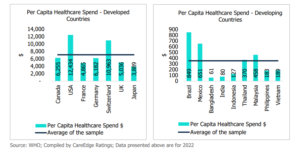India health insurance coverage is expected to hit 50% this year according to research from India-based ratings agency CareEdge Ratings.
And India is also expected to increase its healthcare spending from 3.3% of gross domestic product (GDP) in 2022 to 5% by 2030.
CareEdge said India’s health insurance coverage (public and private) has more than doubled over the last 10 years, reaching 40% in 2023, largely due to increased awareness and central and state-sponsored health insurance schemes.
But with the recent expansion of the Ayushman Bharat scheme to cover citizens aged 70 years and above, CareEdge says India is likely to expand health insurance coverage to 50% in 2025.
The Ayushman Bharat scheme is a national public health insurance scheme started in 2018 which aims to provide free access to health insurance coverage for low-income earners.
CareEdge said: “India’s healthcare sector is on the cusp of significant transformation, driven by increased public and private investments, policy initiatives, and demographic shifts.”
The report said that as of 2022, India’s healthcare spending accounted for 3.3% of the GDP; however, with sustained efforts, it is anticipated to reach 5% by 2030.
Currently, India’s per capita expenditure on healthcare is about US$80 per year – a low rate even against other developing economies, according to CareEdge.

That compares to a per capita healthcare spend of more than US$12,000 in the USA, leading developed countries, and a per capita healthcare spend of US$849 in Brazil. India ranks between Indonesia with a healthcare spend of US$127 and Bangladesh with US$61.
But CareEdge said: “With structural improvements, including doubling the number of medical seats, increasing insurance coverage (40% of the population), and expanding hospital bed capacity, India’s healthcare infrastructure is expected to improve substantially by 2030.”
CareEdge added: “Higher public spending, along with increased private investments in the healthcare sector, insurance expansion, and demographic shifts, are driving a structural transformation.
“However, constraints in rural healthcare infrastructure and the availability of a trained workforce remain critical challenges in expanding healthcare coverage across different strata of society.”
CareEdge said that despite the current challenges, including disparities in healthcare infrastructure and the availability of medical services in the workforce between urban and rural areas, the future looks promising with sustained efforts and strategic investments.
Krunal Modi, director of CareEdge Ratings, said: “India’s healthcare landscape is evolving rapidly.
“The government’s commitment to increasing healthcare spending, coupled with private sector participation, is laying a strong foundation for improved healthcare access and quality”.
He added: “The doubling of medical seats, expanded health insurance coverage, and continued addition of hospital beds are positive steps towards building a robust healthcare system.
“As we move forward, a balanced approach that incorporates concerted efforts from both the public and private sectors will be essential in achieving our healthcare goals and delivering better health outcomes for all citizens.”






